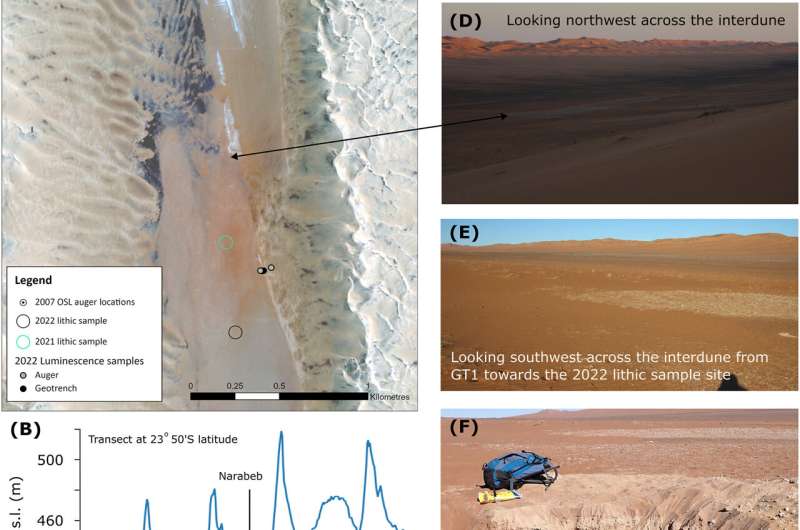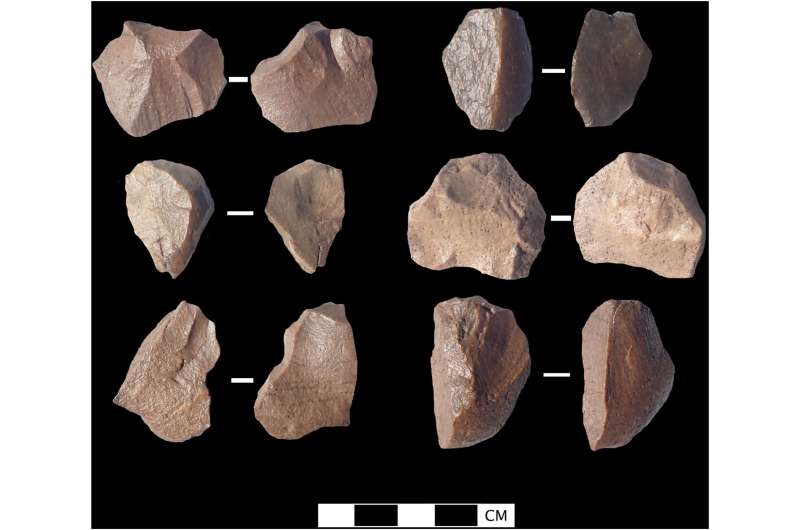This article has been reviewed according to Science X's editorial process and policies. Editors have highlighted the following attributes while ensuring the content's credibility:
fact-checked
trusted source
written by researcher(s)
proofread
Scientists now know when an ancient lake supported human life in the Namib Sand Sea

Desert regions in northern Africa and the Arabian Peninsula have been well studied by archaeologists as the home of early humans and as routes of migration along "green corridors."
The archaeology of southern Africa's west coast desert belt has not received the same attention.
The Namib Sand Sea, part of the Namib Desert, is on the west coast of Namibia. It is a hyperarid landscape of towering dunes, occupying about 34,000km² between the towns of Lüderitz in the south and Walvis Bay in the north. However, there are clues that this environment was not always so dry and inhospitable, suggesting that there is more to be learned about ancient human life here.
We are part of an interdisciplinary research team of physical geographers, archaeologists and geospatial scientists, interested in the long-term history of deserts and human-environmental interactions.
Our research, published in Quaternary Science Advances, provides a timeframe for the presence of a small freshwater lake that once existed in the Namib Sand Sea. This lake was fed by an ancient river and is surrounded by a rich record of stone tools from the African Middle Stone Age (made between about 300,000 years ago and 20,000 years ago), indicating that people ventured into this landscape and used this occasional water source.
Dating the former lake site, Narabeb, makes it clearer when ancient humans would have been able to live here. It draws attention to the Namib Sand Sea as a place archaeologists should study to learn more about far-reaching and deep human connections across southern Africa.
An ancient lake and shifting sand dunes
Today, Narabeb is a landscape dominated by long sand dunes that tower more than 100 meters high over the former lake site. There is no standing water here and the landscape receives little to no rain most years. However, that's probably not what our ancient ancestors would have seen here. Away from the lake, they might have seen a relatively flat plain, seasonally covered by grasses, beside a river.
The clue is in sediments at the site: mud layers that were laid down by water. To find out how long ago the lake was at Narabeb, we needed to date these layers.
We used a technique called luminescence dating—basically, making sand glow to tell the time. Sand grains release a trapped signal that builds up when sand is buried underground, and is reset when sand is exposed to sunlight. Using this technique, we can date when different layers were last on the surface before they got buried. We dated the sand beneath and above layers of mud that were deposited by water. Our results show that the lake was present at Narabeb at some point between 231,000 ± 20,000 and 223,000 ± 19,000 years ago and again about 135,000 ± 11,000 years ago.
Another clue is the shape of the landscape east of Narabeb. It is dune free, reminding us that ancient humans were not the only things migrating in the Namib Sand Sea. Have the dunes been on the move? For how long? And how quickly?
Drilling to the center of these dunes to work that out remains logistically impossible. Instead, we used a novel mathematical model.
The modeling suggests that it would have taken about 210,000 years to accumulate the amount of sand around Narabeb (those 110m high dunes). This number is remarkably close to the oldest age for the lake. This suggests that the dunes may only just have been starting to form and that a river was supplying the lake with fresh water, supporting animals and attracting people. The sediments at Narabeb also clearly tell us that a river once flowed where there are now dunes.
The winds have pushed dunes from the south and west to north and east, creating barriers for the river and hindering movement of people and animals along the water course.

Ancient human presence
At other sites in the Namib we have found Early Stone Age tools from an earlier species of the Homo genus. This is part of a growing body of evidence, adding to research in the Kalahari desert in the center of southern Africa, that suggests southern African desert landscapes are more important to the story of human evolution and technological innovation than has been supposed.
The artefacts from Narabeb fit into the Middle Stone Age type of stone tool technology. Narabeb is a particularly rich site for stone tools, suggesting people made tools here for a long time and perhaps visited the site over many generations.
This research illustrates the need for a comprehensive study of areas that have not been on the map of the major routes of human and animal migration. These might reveal exciting records of cultural diffusion, innovation and adaptation to marginal and changing environments.
Our results also make us think about the dynamic nature of environmental conditions in one of Earth's oldest desert regions. It has long been thought that the Namib has been consistently very dry for around 10 million years and not a place capable of containing "green corridors" at the times of interest for archaeologists. Now we can challenge that idea.
Future steps
Recent funding from the Leverhulme Trust will allow us to extend our fieldwork, documenting archaeological sites and dating these "green corridors" across more of this landscape. A 100 mile (160km) initial foot survey along the ancient river course has revealed an expansive artifact-littered landscape. We also need to know more about where ancient populations found the materials they used to make stone tools.
This will allow us to piece together a network of archaeological sites and show where human migration might have been possible in this part of southern Africa. Up to now, it's been a gap in the archaeological map.
More work is also needed to understand the shifts in climate that allowed the rivers to flow into the Namib. This Southern Hemisphere, west coast desert has a very different setting to north Africa and Arabia, which have good frameworks for understanding their periodic "green corridors." Ongoing work with the wider scientific community, including climate modelers, may create a clearer picture of the Namib's "green corridors."
More information: Abi Stone et al, Landscape evolution and hydrology at the Late Pleistocene archaeological site of Narabeb in the Namib Sand Sea, Namibia, Quaternary Science Advances (2024). DOI: 10.1016/j.qsa.2024.100190
Provided by The Conversation
This article is republished from The Conversation under a Creative Commons license. Read the original article.![]()




















